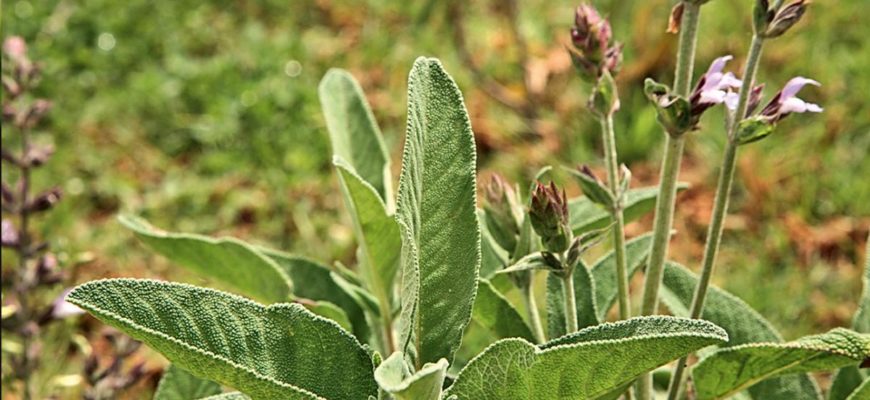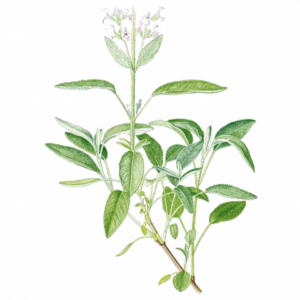
Find out more about the Clary sage plant of our Aromatherapy Herbarium blog series.

CLARY SAGE
Salvia sclarea
DESCRIPTION

Clary sage (Salvia sclarea) is a biennial herbaceous perennial plant of the Lamiaceae family, native to Europe and Western Asia. In the wild, it never grows to more than one–metre in height.
ADVICE
You must not use sage if you have over-indulged in alcohol. The combination of the two causes nausea, vomiting, migraine and nightmares.
Not to be confused with common sage, used for extemporaneous preparations. This latter is reserved for medical use as the essential oil is neurotoxic and abortive!
DO NOT USE IN
– pregnant or breast-feeding women,
– children under the age of twelve years (hormone interference),
– subjects with asthma without the advice of an allergologist before the first use,
– persons having suffered from a hormone-dependent cancer or with serious lesions to hormone-sensitive organs (breasts, ovaries, uterus).
RECIPES
Acne
150 ml in equal proportions of hydrolates of common sage, common lavender, Roman chamomile and rosemary verbenone. For acne-prone skins, use this mixture of hydrolates, that are more gentle than essential oils. When used morning and evening, after washing with neutral or slightly acidic soap, this lotion allows the skin to gently regain its clarity.
Amenorrhoea or premenstrual syndrome
15 to 20 drops of EO of clary sage, 10 ml of CO. Mix the essential oil of clary sage with neutral carrier oil and massage the abdomen in the morning for one to two weeks.

In the wild, it never grows to more than one–metre in height. Its leaves are hairy on both sides; the top of its quadrangular and branched stems are covered with glandular hairs from which the essential oil is extracted. The purple bell-shaped flowers are highly melliferous.
Sage, the queen of medicinal plants, may be hard (sclarea comes from the Greek sklaros, meaning “stiff”), but it is first and foremost salutary (salvia comes from the Latin salvare, meaning “to save”). According to mythology, it grew in abundance in the field where Zeus, the future master of the universe, was breast-fed by Amalthea the goat. It was though to protect against death and to help women give birth. In the Middle Ages, the magician became a saint. Indeed, it was said that, when Joseph and Mary were fleeing Herod’s fierce soldiers with the Divine Child, a sage bush hid them from their pursuers. When mixed with wine, sage improved appetite. It played an important role in the pharmacopoeia and was used to prepare “eau d’arquebuse”. In the 17th century, tea was introduced into Europe by the Dutch following an exchange against sage, deemed much superior by the Chinese. Our grandmothers made sage decoctions to treat gout, food poisoning and… bad moods.
CULTIVATION AND PRODUCTION
Sage is cultivated in Provence, though its once large production has been progressively marginalised by major competitors: United States, China and Ukraine. Worldwide exchanges are estimated at three thousand tonnes.
FRAGRANCE
Clary sage possesses a fruity, amber and musky odour.
EXTRACTION AND YIELD
Sage leaves are harvested at the end of June and dried slowly in the shade. The essential oil is obtained by steam distillation of the leaves and flowering tops, with a maximum yield of 0.18%, i.e. one hundred and eighty grams of essential oil from one hundred kilograms of plant.
CHEMICAL FORMULA
The main active constituents of essential oil of Salvia sclarea, that contains some two hundred and fifty, are monoterpenols (linalool), diterpenols (sclareol), terpene esters (linalyl acetate) and coumarins.
MAIN INDICATIONS
Essential oil of clary sage is oestrogen-like and has the same effect as natural oestrogens. It relieves premenstrual stress, helps regulate irregular cycles and combats pre-menopause and menopause-related disorders (hot flushes, night sweats and mood swings). It is a good skin and hair sebum regulator; it also curbs excessive perspiration.


Leave a Comment